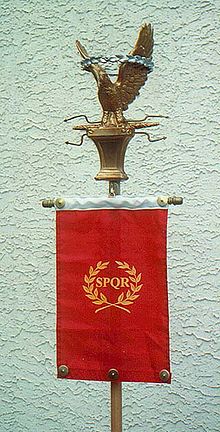|
Greek city of
Berytus (Berytos) in
Phoenicia
Time of
Augustus –
Roman Emperor: 27 B.C. – 14 A.D.
Bronze 14mm (2.37 grams)
Reference: RPC I 4538; Rouvier 490; Sawaya 255 (D60/R116)
Eagle standing left, with wings spread, on thunderbolt.
Large AVG.
You are bidding on the exact item pictured,
provided with a Certificate of Authenticity and Lifetime Guarantee of
Authenticity.
Jupiter is usually thought to have originated as a
sky god. His identifying implement is the
thunderbolt
, and his primary sacred animal is
the eagle, which held precedence over other birds in the taking of
auspices
and became one of the most

 common common
symbols of the
Roman army
(see
Aquila
). The two emblems were often combined to
represent the god in the form of an eagle holding in its claws a thunderbolt,
frequently seen on Greek and Roman coins. As the sky-god, he was a divine
witness to oaths, the sacred trust on which justice and good government depend.
Many of his functions were focused on the
Capitoline
(“Capitol Hill”), where the
citadel
was located. He was the chief deity of
the
early Capitoline Triad
with
Mars
and
Quirinus
. In the
later Capitoline Triad
, he was the central
guardian of the state with
Juno
and
Minerva
. His sacred tree was the oak. The
Romans regarded Jupiter as the
equivalent
of the Greek
Zeus, and in
Latin literature
and
Roman art
, the myths and iconography of Zeus
are adapted under the name Iuppiter.
An aquila, or eagle, was a prominent symbol used in
ancient Rome, especially as the
standard
of a
Roman legion
. A
legionary
known as an
aquilifer
, or eagle-bearer, carried this
standard. Each legion carried one eagle. The eagle was extremely important to
the Roman military, beyond merely being a symbol of a legion. A lost standard
was considered an extremely grave occurrence, and the Roman military often went
to great lengths to both protect a standard and to recover it if lost; for
example, see the aftermath of the
Battle of the Teutoburg Forest
, where the
Romans spent decades attempting to recover the lost standards of three legions.
Berytos in Phoenicia
History
Beirut’s history goes back more than 5000 years.
Excavations in the
downtown
area have unearthed layers of Phoenician, Hellenistic, Roman, Arab
and Ottoman remains.
The first historical reference to Beirut dates from the 14th century BC, when it
is mentioned in the
cuneiform
tablets of the “Amarna
letters.” Ammunira
of Biruta[10]
(Beirut) sent three letters to the
pharaoh of Egypt
.
Biruta is also referenced in the letters from
Rib-Hadda
of Byblos
. The
most ancient settlement was on an island in the river that progressively silted
up. The city was known in antiquity as Berytus (Βηρυτός) (see also
List of traditional Greek place names
); this name was taken in 1934 for the
archaeological journal published by the Faculty of Arts and Sciences at the
American University of Beirut
.

Canaanean Blade
. Suggested to be
part of a
javelin
. Fresh grey
flint
, both sides showing
pressure flaking
. Somewhat narrower
at the base, suggesting a
haft
. Polished at the extreme
point. Found on land of the Lebanese Evangelical School for Girls in
the
Patriarchate
area of Beirut.
Hellenistic/Roman
period
In 140 BC, the city was destroyed by
Diodotus Tryphon
in his contest with
Antiochus VII Sidetes
for the throne of the
Seleucid
monarchy. Beirut was soon rebuilt on a more regularized
Hellenistic
plan, renamed Laodicea in Phoenicia (Greek:
Λαοδικεια ή του Φοινίκη) or Laodicea in
Canaan, in honor of a Seleucid
Laodice
. The modern city overlies the ancient one and little archaeology had
been accomplished until after the end of the civil war in 1991; now large sites
in the devastated city center have been opened to archaeological exploration. A
dig in 1994 established that one of Beirut’s modern streets, Souk Tawile, still
follows the lines of an ancient Hellenistic and Roman one.
Mid-first century coins of Berytus bear the head of
Tyche
, goddess of
fortune; on the reverse, the city’s symbol appears: a dolphin entwines an
anchor. This symbol was taken up by the early printer
Aldus Manutius
in 15th century
Venice
. Beirut
was conquered by Agrippa in 64 BC and the city was renamed in honor of the
emperor’s daughter, Julia; its full name became Colonia
Julia Augusta
Felix Berytus.
The veterans of two
Roman
legions
were established in the city: the fifth Macedonian and the third
Gallic. The city quickly became Romanized. Large public buildings and monuments
were erected and Berytus enjoyed full status as a part of the empire.
Under the Romans, it was enriched by the dynasty of
Herod the Great
, and was made a
colonia
, Colonia Iulia Augusta Felix Berytus, in 14 BC. Beirut’s
school of law was widely known at the time.
Two of Rome’s most famous jurists,
Papinian
and Ulpian
, both natives of Phoenicia, taught at the law school under the
Severan
emperors. When
Justinian
assembled his
Pandects
in the 6th century, a large part of the corpus of laws were
derived from these two jurists, and Justinian recognized the school as one of
the three official law schools of the empire (533). Within a few years, as the
result of a disastrous earthquake (551),
the students were transferred to
Sidon
.
About 30,000 were killed in Berytus alone and, along the Phoenician coast, total
casualties were close to 250,000.
|






 common
common



